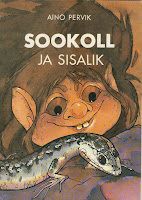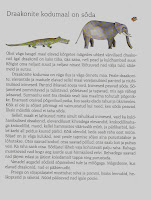Oli kord mees, kes elas üksinda, kellel polnud kedagi kellega rääkida. Tal oli lennuki õnnetus ja maandus Sahara kõrbes. Äkki palus üks väike hääl ta kõrval, et joonistagu talle lammast. Esimene lammas oli haige, teine oli hoopis oinas, kolmas oli liiga vana. Mehe kannatus sai otsa ja kritseldas lihtsalt väikese karbi. Selle sees oli lammas. Ja just see lammas meeldis väikese häälele, kes oli Väike prints.
These classic children's books for young readers and their parents are available at Võlusaared-Magic Isles, the TES Schools library. If you have read them, please comment! If you can recommend others, please do so! Weekly Estonian book updates, old and new, are coming! Keep checking in! For more information, please email us at:
speakesto@gmail.com

Väike prints
Written and illustrated by Antoine de Saint-Exupéry, 79 pages
2003 Tiritamm
Saint-Exupéry wrote The Little Prince in 1942 while living in New York City and Long Island, NY. It was first published in 1943 and is based on his experience as an international aviation courier (he delivered mail from Touluse to Dakar). He and his co-pilot crashed in the Sahara and were resued by a bedouin; they were lucky to be found alive.
Terre des Hommes (Sand, Wind, Stars), 1939, was the basis for Expo 67 in Montreal, Canada - better known as Man and his World.
In this Ott Ojamaa translation (published in 1966 and reprinted many times) the language is clear and concise, compared to
a later translation.


Väikese eurooplase lugemik
Lauri Leesi, illustrated by Joonatan Noor, 256 pages
1999 Avita
A collection of well known Estonian and European stories and poems written by Anna Haava, Betti Alver, Oscar Wilde, Rudyard Kipling, Oscar Luts and Voltaire, among others.
Lauri Leesi has been teaching at the Tallinna Prantsuse Lütseum (Tallinn French Academy) since 1992 and has won may awards, including the French Legion of Honour.


Sookool ja sisalik
Aino Pervik, illustrated by Piret Selberg, 79 pages
Eesti Raamat 1986
Not Shrek! This is a real mud ogre who undergoes a change of heart in his search for a lizard. Aino Pervik is a children's author, well known for her Paula series. As this is an older book, the language is simpler and and the illustrations are cute. Aino Pervik's books are available
here.

Draakonid võõrsil
Aino Pervik, illustrated by Piret Raud, 64 pages
2002 Tiritamm
This whimsical tale about dragons takes place in a mythical Estonia quite different to that of Kalevipoeg. It is a story of fighting without the gore that we usually see on modern media. The language is clear but with longer and modern words.
Piret Raud is a wonderful illustrator, who worked with her mother Aino on the Paula series and others. Pätu and Härra Q are also in our library collection.

















